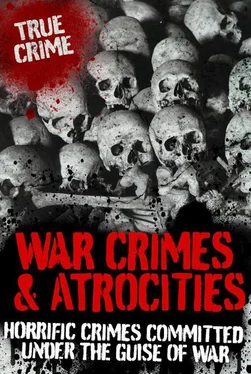Unfortunately, this was a short-lived victory for humanitarian standards and common decency in Nazi Germany. Within only a few months, the T4 team of doctors, nurses and administrators had been given a new task. They were to perform the same role in another killing programme, that of exterminating the Jewish population under the terms of the ‘final solution’. And, although the systematic murdering of the mentally and physically impaired ceased after 1941, the killings continued at a local level. Patients were no longer sent to the gas chambers, but were given lethal injections or starved to death.
THE AFTERMATH
After the war, the full scale of the horror regarding T4 programme emerged. In December 1946, 23 doctors and adminstrative staff, including Hitler’s personal doctor Dr Karl Brandt, and the chief organizer of the programme Viktor Brack, were tried for their part in war crimes and crimes against humanity. The crimes included the systematic murder of physically and mentally ill people, and those with disabilities. Brandt and Brack, along with several others, were convicted and sentenced to death. They were executed in 1948. Philipp Bouler and Leonardo Conti, both leading Nazi medical officers, were also sent to trial, but they killed themselves while in prison.
In October 2006, skeletons of children and adults believed to have been part of the T4 ‘euthanasia programme’ were unearthed in what appeared to be a mass grave in a cemetery at the village of Menden-Barge. The cemetery was near to the site of a former hospital run by Brandt, where mental patients had been gassed to death.
February 1945

The bombing of Dresden in February 1945, during World War II, is considered by many to be a war crime, committed by the Allies against the German nation. This is because a heavily populated civilian area was specifically targeted and bombed on an enormous scale, using incendiary bombs to create a firestorm on the ground to maximize the death toll. So many bombs were dropped over the city by British and American aeroplanes that the area became a sheet of fire, drawing in cold air towards it like a tornado, and sucking in human bodies to be consumed in the flames. Eyewitness accounts of the bombing tell of extraordinary sights, such as seeing people reduced to cinders in front of their eyes, and whole streets blackened and burnt so badly that they were no longer recognizable.
The total weight of bombs dropped on Dresden was far greater than any bombing hitherto during the British air campaign and the bombing seems to have lacked any particular rationale, beyond creating sheer panic and terror in the population and thus destroying civilian morale. For these reasons, many doubt that it was necessary to wreak quite such appalling devastation on one of Germany’s most crowded cities, especially considering the chaos and confusion that its inhabitants were already experiencing as a result of refugees fleeing to it from other areas of Germany.
However, there are those who maintain that the bombing was necessary to hasten the end of the war, and that to that degree it may have saved lives, at least on the Allied side. After the war, Air Marshal Arthur Harris of RAF Bomber Command – the man who helped to introduce the policy of ‘area bombing’ (or ‘terror bombing’ as it was known in Germany) – came under intense criticism for his part in the attack. However, he argued that the city was an important military target, being a communications centre for German defence, and that it was fully justified in the context of the war.
The policy of ‘area bombing’ (that is, directly bombing German cities and towns) had been advocated since by Charles Portal of the British Air Staff, and there had been attacks on Berlin and other German cities. These had not been successful, but they had encouraged the Germans to switch their air attacks from British military targets to urban areas. Many argued that this had helped the British win the Battle of Britain but had also invited the Blitz, which ravaged London during the war. In 1941, in conjunction with Arthur Harris, the Head of RAF Bomber Command, Portal introduced the policy of blanket bombing of urban areas at night to cause maximum civilian casualties. The campaign targeted Cologne, Hamburg, Nuremberg and Dresden, and is thought to have killed 600,000 civilians; the deaths of pilots were high, too, and more than 50,000 airforce personnel were killed in the raids. Eventually, the death toll from the campaign became too high, and the British prime minister, Winston Churchill, ordered that it should be abandoned. This was partly because Churchill did not want the whole country to be destroyed by the time the British won the war, which seemed likely by 1945.
MASSIVE FIRESTORM
The bombing attack on Dresden began on the evening of 13 February, 1945. First, British planes began to drop incendiary bombs, packed with magnesium, phosphorus, napalm and other combustible materials, onto the city, creating a massive fire that raged through the streets. Harris specifically intended this firestorm to be created, which shocked some of the pilots dropping the bombs. One wireless operator who took part in the raid, Roy Akehurst, recalled:
We seemed to fly for hours over a sheet of fire – a terrific red glow with a thin haze over it. I found myself making comments to the crew: ‘Oh God, those poor people.’ It was completely uncalled for. You couldn’t justify it.
On the ground, the scene was worse than the worst nightmare. High buildings caught fire, creating a mass of hot air rushing upwards like a tornado, sucking up people and throwing them into the flames. Citizens fled through the burning streets to cellars, many of them fainting from the fumes and being burnt to cinders in front of onlookers. All the electricity in the city was out, so people were stumbling about in the darkness, clutching their children, many of whom were swept up in the flames. Down in the cellars, the dead and dying lay next to those who were still alive, and many were trampled to death as more and more people tried to cram in to get out of the firestorm.
The situation for those on the ground became worse when the weather cleared and the bombers were able to see their target better. American bombers were now called in, and a second wave of bombing began during daylight hours, in which the city was almost totally destroyed. Thousands were killed in the process in a most agonizing and painful way, being burnt to death. It is difficult to put an exact figure on the number of people who died, because so many bodies were completely incinerated in the firestorm, becoming cinders and ashes, but it has been estimated that the total death toll was around 35,000. However, some researches put the figure much higher, at around 100,000.
Whatever the truth of the matter, there is no doubt that the bombing of Dresden was one of the most destructive events of World War II. Almost the entire population was killed or injured, and few buildings were left standing. Sadly, Dresden had been a beautiful city, dating from medieval times, with many fascinating buildings and monuments that were a testament to the glories of German culture. Thus, its destruction was regarded not only as catastrophe on humanitarian grounds, but as a blow to European architecture, art and civilization.
CONTROVERSY
In the wake of the tragedy, there was great controversy about what had happened. After the war, the military personnel involved gave their side of the story, arguing that the bombing had been an effective way of bringing the war to a hasty close, thus saving the lives of hundreds of their men. In the view of Robert Saunby, Deputy Air Marshal at Bomber Command:
Читать дальше













